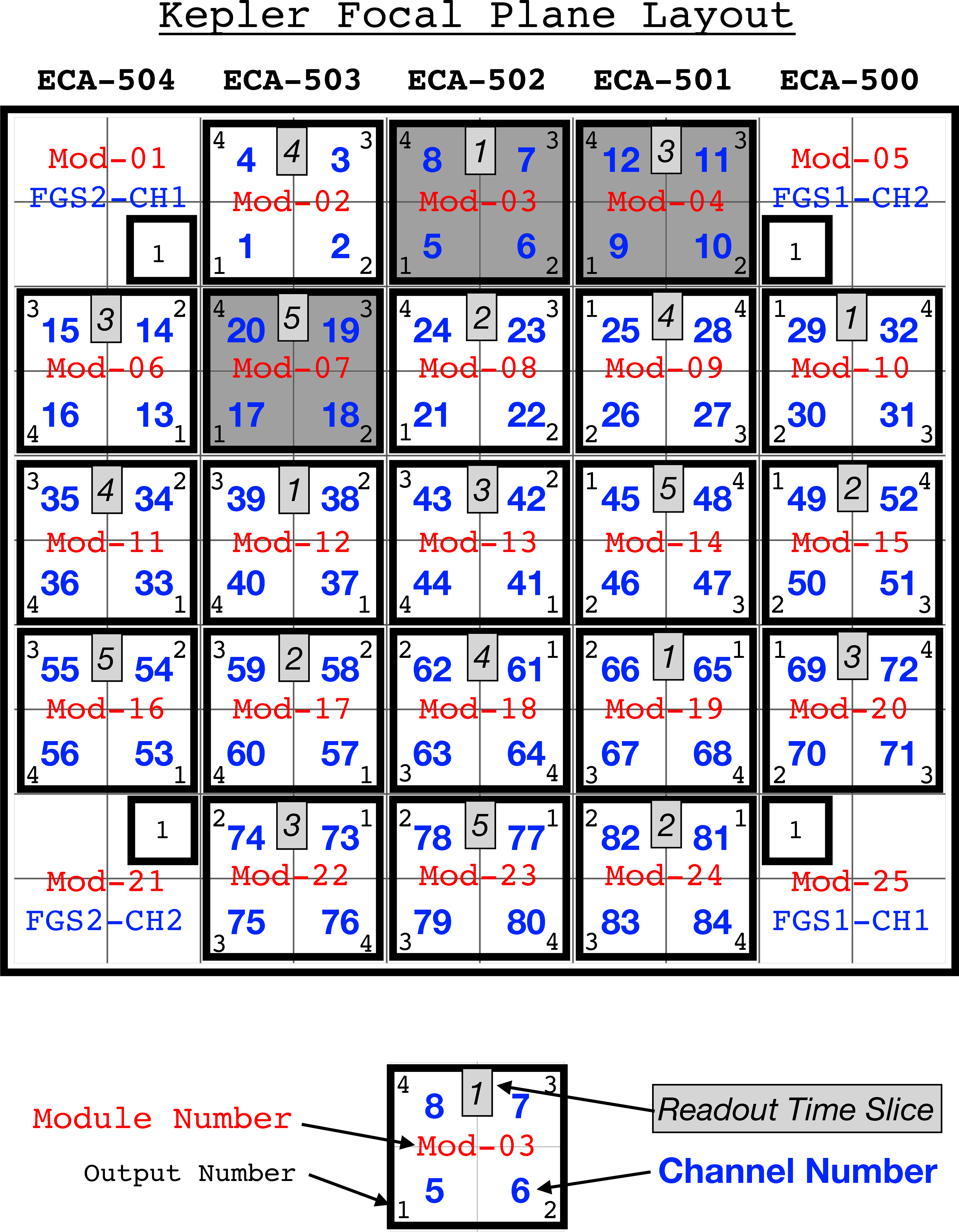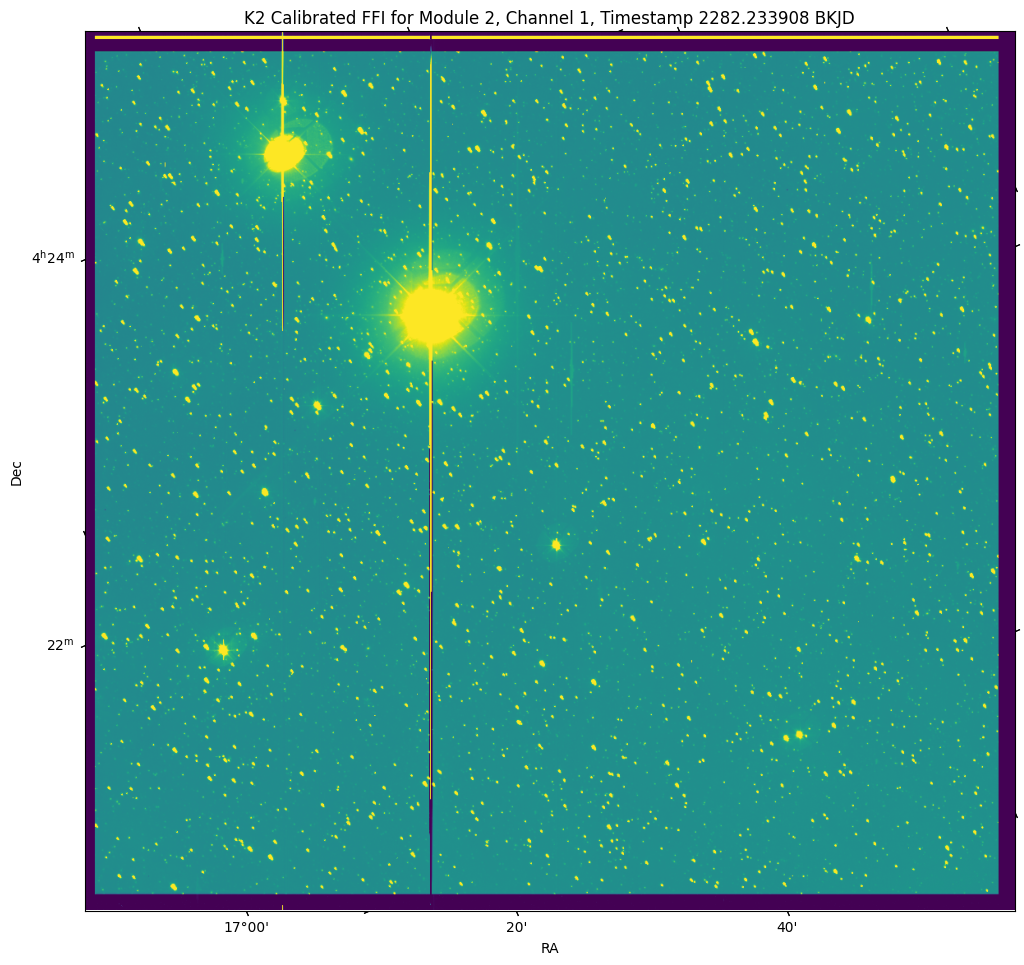Beginner: Read and Display a K2 Full Frame Image#
This notebook tutorial demonstrates how to load and display a K2 full frame image (FFI). We will display the image with the world coordinate system (WCS) overlayed on top.
Import Statements#
astropy.io.fits allows us to interact with the FITS files.
astropy.wcs.WCS allows us to interpret the world coordinate system.
matplotlib.pyplot is used to display the image.
numpy is used for array manipulation.
%matplotlib inline
from astropy.io import fits
from astropy.wcs import WCS
import matplotlib.pyplot as plt
import numpy as np
Introduction#
K2 reads out the entire frame of all its cameras once or twice per Campaign and stores them as full frame images. The total size on sky of the Kepler field-of-view is ~116 square degrees, although a few of the 21 modules had failed before the start of the K2 mission.
This tutorial will refer to a couple K2-related terms that we define here.
Campaign = During the K2 mission, the Kepler telescope observed the sky in a given pointing along the ecliptic plane for approximately 80 days at a time. Each of these regions is referred to as a “Campaign”, starting with Campaign 0 and ending with Campaign 19. There was also a special “Engineering” Campaign before Campaign 0 that lasted ~10 days.
HDU = Header Data Unit. A FITS file is made up of HDUs that contain data and metadata relating to the file. The first HDU is called the primary HDU, and anything that follows is considered an “extension”, e.g., “the first FITS extension”, “the second FITS extension”, etc.
BJD = Barycentric Julian Date, the Julian Date that has been corrected for differences in the Earth’s position with respect to the Solar System center of mass.
BKJD = Barycentric Kepler Julian Date, the timestamp measured in BJD, but offset by 2454833.0. I.e., BKJD = BJD - 2454833.0
WCS = World Coordinate System, A FITS convention used to store coordinate information inside FITS headers. For K2 full frame images, it is used to provide the translation needed to go from pixel coorindates to celestial coordinates in right ascension and declination.
Obtaining The Full Frame Image#
We will read the calibrated full frame image from Campaign 1 using the MAST URL location. So that we can get started with understanding the file contents without reviewing how to automatically search for and retrieve K2 files, we won’t show how to search and retrieve K2 FFIs in this tutorial.
# For the purposes of this tutorial, we just know the MAST URL location of the file we want to examine.
fits_file = "https://archive.stsci.edu/missions/k2/ffi/ktwo2015092174954-c04_ffi-cal.fits"
Understanding The FFI FITS File Structure#
K2 FFI FITS files contain a primary HDU with metadata stored in the header. There are then 84 extensions (21 modules * 4 channels per module) that contain more metadata in the header and stores the full frame image for that module+channel. Note that all 84 modules are included in the FFI FITS file, even if some of them do not have image data. Let’s examine the structure of the FITS file using the astropy.fits info function, which shows the FITS file format in more detail. Note this file is quite large and may take a few moments to dowload.
fits.info(fits_file)
Filename: /home/runner/.astropy/cache/download/url/7133df9c8b3174c962d802cbd0cc912a/contents
No. Name Ver Type Cards Dimensions Format
0 PRIMARY 1 PrimaryHDU 60 ()
1 MOD.OUT 2.1 1 ImageHDU 101 (1132, 1070) float32
2 MOD.OUT 2.2 1 ImageHDU 101 (1132, 1070) float32
3 MOD.OUT 2.3 1 ImageHDU 101 (1132, 1070) float32
4 MOD.OUT 2.4 1 ImageHDU 101 (1132, 1070) float32
5 MOD.OUT 3.1 1 ImageHDU 68 (1132, 1070) float32
6 MOD.OUT 3.2 1 ImageHDU 68 (1132, 1070) float32
7 MOD.OUT 3.3 1 ImageHDU 68 (1132, 1070) float32
8 MOD.OUT 3.4 1 ImageHDU 68 (1132, 1070) float32
9 MOD.OUT 4.1 1 ImageHDU 101 (1132, 1070) float32
10 MOD.OUT 4.2 1 ImageHDU 101 (1132, 1070) float32
11 MOD.OUT 4.3 1 ImageHDU 101 (1132, 1070) float32
12 MOD.OUT 4.4 1 ImageHDU 101 (1132, 1070) float32
13 MOD.OUT 6.1 1 ImageHDU 101 (1132, 1070) float32
14 MOD.OUT 6.2 1 ImageHDU 101 (1132, 1070) float32
15 MOD.OUT 6.3 1 ImageHDU 101 (1132, 1070) float32
16 MOD.OUT 6.4 1 ImageHDU 101 (1132, 1070) float32
17 MOD.OUT 7.1 1 ImageHDU 68 (1132, 1070) float32
18 MOD.OUT 7.2 1 ImageHDU 68 (1132, 1070) float32
19 MOD.OUT 7.3 1 ImageHDU 68 (1132, 1070) float32
20 MOD.OUT 7.4 1 ImageHDU 68 (1132, 1070) float32
21 MOD.OUT 8.1 1 ImageHDU 101 (1132, 1070) float32
22 MOD.OUT 8.2 1 ImageHDU 101 (1132, 1070) float32
23 MOD.OUT 8.3 1 ImageHDU 101 (1132, 1070) float32
24 MOD.OUT 8.4 1 ImageHDU 101 (1132, 1070) float32
25 MOD.OUT 9.1 1 ImageHDU 101 (1132, 1070) float32
26 MOD.OUT 9.2 1 ImageHDU 101 (1132, 1070) float32
27 MOD.OUT 9.3 1 ImageHDU 101 (1132, 1070) float32
28 MOD.OUT 9.4 1 ImageHDU 101 (1132, 1070) float32
29 MOD.OUT 10.1 1 ImageHDU 101 (1132, 1070) float32
30 MOD.OUT 10.2 1 ImageHDU 101 (1132, 1070) float32
31 MOD.OUT 10.3 1 ImageHDU 101 (1132, 1070) float32
32 MOD.OUT 10.4 1 ImageHDU 101 (1132, 1070) float32
33 MOD.OUT 11.1 1 ImageHDU 101 (1132, 1070) float32
34 MOD.OUT 11.2 1 ImageHDU 101 (1132, 1070) float32
35 MOD.OUT 11.3 1 ImageHDU 101 (1132, 1070) float32
36 MOD.OUT 11.4 1 ImageHDU 101 (1132, 1070) float32
37 MOD.OUT 12.1 1 ImageHDU 101 (1132, 1070) float32
38 MOD.OUT 12.2 1 ImageHDU 101 (1132, 1070) float32
39 MOD.OUT 12.3 1 ImageHDU 101 (1132, 1070) float32
40 MOD.OUT 12.4 1 ImageHDU 101 (1132, 1070) float32
41 MOD.OUT 13.1 1 ImageHDU 101 (1132, 1070) float32
42 MOD.OUT 13.2 1 ImageHDU 101 (1132, 1070) float32
43 MOD.OUT 13.3 1 ImageHDU 101 (1132, 1070) float32
44 MOD.OUT 13.4 1 ImageHDU 101 (1132, 1070) float32
45 MOD.OUT 14.1 1 ImageHDU 101 (1132, 1070) float32
46 MOD.OUT 14.2 1 ImageHDU 101 (1132, 1070) float32
47 MOD.OUT 14.3 1 ImageHDU 101 (1132, 1070) float32
48 MOD.OUT 14.4 1 ImageHDU 101 (1132, 1070) float32
49 MOD.OUT 15.1 1 ImageHDU 101 (1132, 1070) float32
50 MOD.OUT 15.2 1 ImageHDU 101 (1132, 1070) float32
51 MOD.OUT 15.3 1 ImageHDU 101 (1132, 1070) float32
52 MOD.OUT 15.4 1 ImageHDU 101 (1132, 1070) float32
53 MOD.OUT 16.1 1 ImageHDU 101 (1132, 1070) float32
54 MOD.OUT 16.2 1 ImageHDU 101 (1132, 1070) float32
55 MOD.OUT 16.3 1 ImageHDU 101 (1132, 1070) float32
56 MOD.OUT 16.4 1 ImageHDU 101 (1132, 1070) float32
57 MOD.OUT 17.1 1 ImageHDU 101 (1132, 1070) float32
58 MOD.OUT 17.2 1 ImageHDU 101 (1132, 1070) float32
59 MOD.OUT 17.3 1 ImageHDU 101 (1132, 1070) float32
60 MOD.OUT 17.4 1 ImageHDU 101 (1132, 1070) float32
61 MOD.OUT 18.1 1 ImageHDU 101 (1132, 1070) float32
62 MOD.OUT 18.2 1 ImageHDU 101 (1132, 1070) float32
63 MOD.OUT 18.3 1 ImageHDU 101 (1132, 1070) float32
64 MOD.OUT 18.4 1 ImageHDU 101 (1132, 1070) float32
65 MOD.OUT 19.1 1 ImageHDU 101 (1132, 1070) float32
66 MOD.OUT 19.2 1 ImageHDU 101 (1132, 1070) float32
67 MOD.OUT 19.3 1 ImageHDU 101 (1132, 1070) float32
68 MOD.OUT 19.4 1 ImageHDU 101 (1132, 1070) float32
69 MOD.OUT 20.1 1 ImageHDU 101 (1132, 1070) float32
70 MOD.OUT 20.2 1 ImageHDU 101 (1132, 1070) float32
71 MOD.OUT 20.3 1 ImageHDU 101 (1132, 1070) float32
72 MOD.OUT 20.4 1 ImageHDU 101 (1132, 1070) float32
73 MOD.OUT 22.1 1 ImageHDU 101 (1132, 1070) float32
74 MOD.OUT 22.2 1 ImageHDU 101 (1132, 1070) float32
75 MOD.OUT 22.3 1 ImageHDU 101 (1132, 1070) float32
76 MOD.OUT 22.4 1 ImageHDU 101 (1132, 1070) float32
77 MOD.OUT 23.1 1 ImageHDU 101 (1132, 1070) float32
78 MOD.OUT 23.2 1 ImageHDU 101 (1132, 1070) float32
79 MOD.OUT 23.3 1 ImageHDU 101 (1132, 1070) float32
80 MOD.OUT 23.4 1 ImageHDU 101 (1132, 1070) float32
81 MOD.OUT 24.1 1 ImageHDU 101 (1132, 1070) float32
82 MOD.OUT 24.2 1 ImageHDU 101 (1132, 1070) float32
83 MOD.OUT 24.3 1 ImageHDU 101 (1132, 1070) float32
84 MOD.OUT 24.4 1 ImageHDU 101 (1132, 1070) float32
The image below shows the layout of the Kepler modules and channel numbers, for reference.

Reading the WCS and Calibrated Image#
Now that we have the file, let’s store the world coordinate system information for use later. We can use the astropy.wcs WCS function to store the information from the image extension HDU’s header.
The following command opens the file, extracts the WCS and Image data and then closes the file.
with fits.open(fits_file, mode = "readonly") as hdulist:
wcs_info = WCS(hdulist[1].header)
cal_image = hdulist[1].data
header = hdulist[1].header
WARNING: FITSFixedWarning: 'datfix' made the change 'Set MJD-OBS to 57114.722560 from DATE-OBS.
Set MJD-END to 57114.742994 from DATE-END'. [astropy.wcs.wcs]
# Use the header to determine the mid-point of the exposure time for this FFI.
mid_time = (header['TSTOP'] + header['TSTART']) / 2
Display the Image#
We show the full image from Module 2 Channel1, adjusting the scale so that we can see more of the stars. We also imprint the WCS on top of the image.
plt.figure(figsize = (12,12))
plt.subplot(111, projection = wcs_info)
plt.imshow(cal_image, vmin = np.percentile(cal_image,4),vmax = np.percentile(cal_image, 98),origin = "lower")
plt.xlabel('RA')
plt.ylabel('Dec')
plt.title("K2 Calibrated FFI for Module 2, Channel 1, Timestamp %f BKJD" % mid_time)
Text(0.5, 1.0, 'K2 Calibrated FFI for Module 2, Channel 1, Timestamp 2282.233908 BKJD')

A Few Image Details#
We describe some of the details you see on this FFI. For more detailed information please see the Kepler Instrument Handbook. Calibration row and columns are read-out in addition to the image data. These rows and columns remain in the calibrated image.
Leading and Trailing Black#
Each output channel have 12 columns for the “leading black” and 20 columns for the “trailing black”, used to determine reference levels and undershoot amplitudes.
Virtual, Smear and Buffer#
The top 26 rows are used to measure smear content, four of those rows are virtual rows, used to monitor undershoot and gain, and to clean out radiation traps.
About this Notebook#
Authors: Scott W. Fleming and Susan E. Mullally, STScI Archive Scientists
Updated On: 2019-01-30

